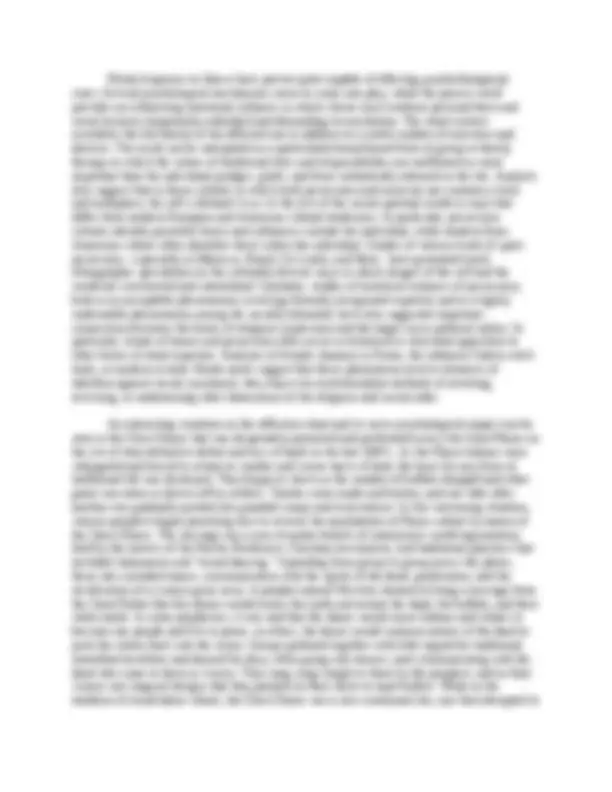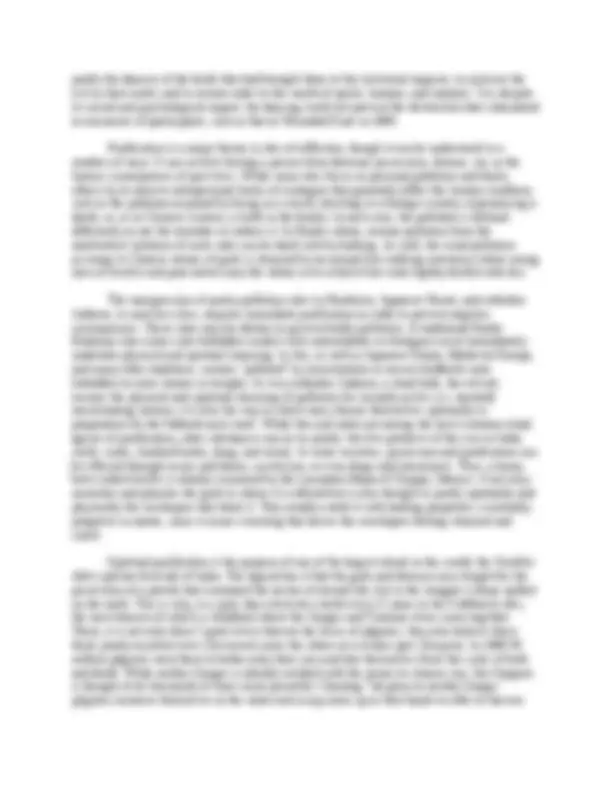





Study with the several resources on Docsity

Earn points by helping other students or get them with a premium plan


Prepare for your exams
Study with the several resources on Docsity

Earn points to download
Earn points by helping other students or get them with a premium plan
Community
Ask the community for help and clear up your study doubts
Discover the best universities in your country according to Docsity users
Free resources
Download our free guides on studying techniques, anxiety management strategies, and thesis advice from Docsity tutors
The concept of 'rites of affliction,' ceremonies used to deal with various forms of misfortune, including illness, reproductive disorders, and natural disasters. How these rituals are found in many cultures and can be understood as attempts to redress imbalances and restore order. Examples are given from different historical and contemporary societies, including china, korea, and the plains indians. Healing rituals are a common theme, with an emphasis on the social and spiritual causes of illness and the role of shamans in traditional societies.
Typology: Study notes
1 / 5

This page cannot be seen from the preview
Don't miss anything!




S/A 4074: Ritual and Ceremony Lecture 19: Rites of Affliction Rites of affliction are those ceremonies that attempt to deal with the influence of spirits afflicting humans with various types of misfortune. Thus Victor Turner, in his studies of the Ndembu, found that when divination revealed that an individual had been “caught” by a spirit of the dead, an elaborated ritual was performed to appease and dismiss the troublesome spirit. Such spirits were commonly claimed by this people to be responsible for problems in hunting, women’s reproductive disorders, and various forms of illness. While rituals of affliction like these are found in many cultures, the category can be broadened to include other understandings of affliction, including those one brings on oneself (sin, karma, hubris), as well as those reoccurring afflictions such as, in some cultures, the claimed pollution of menstruation, childbearing, and death, that are morally neutral but still require purification. In all such cases, rites of affliction seek to rectify a state of affairs that has been disturbed or disordered; they heal, exorcise, protect, and purify. The type of ritual and expert employed will depend completely on the way in which a culture interprets the problematic state of affairs. One may diagnose an illness as bad luck due to an incomplete process of creation at the beginning of the world, or as possession by spirits and prescribe a formal exorcism. Another might see it as the ravages of sin and prescribe confession and rigorous penance, while a more secular society might see it all as the result of repressed childhood trauma and prescribe several years of expensive ritual visits to the couch of a psychoanalyst. Within this broad category, the dynamics of ritual try to redress the development of anomalies or imbalances. Across the board, this takes the form of purging the body and mind of all impurities, which are no other than forces that have intruded upon the body-mind holism and disturbed its natural state. In some cases it may also involve the intercession of powerful beings to rectify intrusions and imbalances that go beyond the body of a single person. Those things deemed out of order are often meteorological in nature. Many historical and contemporary accounts illustrate a wide variety of rituals to bring rain in times of drought or protection in times of flood, pestilence, and other dangers. The logic of many rainmaking rites appears to follow the idea of “sympathetic magic” whereby like produces like. Thus people squirt water on each other, imitate aquatic birds, or set out pots to draw down the rain. In other cases, people invoke the gods in control of such conditions, as the Greeks did Zeus. In Santa Barbara, CA, citizens paraded a statue of the Virgin Mary in the late 1980's. This is akin to the more aggressive methods used in ancient/Medieval China, when statues of unresponsive gods would be taken out of their cool temples and set out to roast in the sun so that they would know firsthand the people’s suffering and do something about it. This is supplemented by a poem in which people ask a divine being for a favor, noting that he depends upon worshipers for his divinity. If it rains within a set time, thanks and worship will be his. Otherwise, the disgrace will be on his head. Other Chinese practices involve female shamans, secular officials, even emperors exposing themselves to the heat of the sun or a ring of fire to show their willingness to assume personal blame for the drought and provoke the mercy of the gods.
Healing rituals are particularly common, expressing understandings of the nature of physical and mental infirmity that usually differ considerably from the rather recent scientific etiologies used in modern medicine. Yet, it is important to remember that these rites tend to address factors simply not dealt with by scientific medicine and thus often exist alongside it even today. For example, supernatural forces that are usually brought to bear on the situation are not only meant to address the physical dimensions of a condition like smallpox or infertility, but the psychological and social dimensions as well. While Western medicine is based on the idea that disease is a condition within the individual body system, many other healing therapies are rooted in the understanding that disease takes root when key social relations - among the living or among the living and the dead - are disturbed. Rectification of these relationships are an important part of what traditional healing is all about. Indeed, even if someone recognizes that diseases like infant dysentery are caused by bacteria and treat it accordingly, bacteria do not explain why one child sickens and another does not. That type of explanation is sought elsewhere, usually in terms of social or cosmological factors. “Reality rests on the relations between one human being and another, and between all people and spirits.” This doesn’t mean that physical and mental illnesses are simply attributed to invisible forces whose mere existence, aside from any responsibility for the problem, cannot be proven or disproven. Instead, it means that health and illness are understood as symptoms of a broadly conceived realm of order or disorder that draws no hard and fast boundaries between the individual and the community, the mind and the body, or the material and the spiritual. In traditional Korean society, healing has been a central domain of the traditional shaman, the mansin or mudang. This is most commonly a woman who experiences the descent of a spirit into her, often after a mysterious illness that may eventually be diagnosed as possession sickness ( sinbyong ). When she accepts her new calling, the spirits allow her to recover. She then undergoes the training and initiation necessary for her to do her work. Her healing powers are exercised through 2 main rituals: a divinatory session ( chom) where the problem is diagnosed, and an exorcistic ritual ( kut ), where the problem is rectified. A person, family, or whole village can consult a mansin and sponsor a kut, which is believed to have both curative and prophylactic powers. The kut may be a small affair held in the home, or a major public event held outdoors for 3-7 nights, involving 7-8 mansin, many musicians, and tables laden with offerings to ancestors and gods. At a typical divination session, the mansin questions her client closely, sometimes going into a trance to find the cause of the problem (e.g. a sick daughter in law may be explained by an ancestor one had previously quarreled with and who feels he was not properly honored by commemoration services. Thus, he must be honored properly with a kut). The kut itself will last from dawn to late evening, including a series of seances with a fixed pantheon of gods. Each seance has 3 stages: (1) when the god is summoned, the mansin dances to slow music and goes into a trance; (2) the music gets fast and loud and the god arrives by possessing the mansin. S/he assumes the distinctive manner and speech of the deity and issues a divine message ( kongsu ) explaining the illness and how to heal it. If an evil spirit is said to be responsible, the god possessing the mansin dances around the patient to drive it out. A straw doll wearing a bit of the sick person’s clothing may also be burned after the possessed mansin has driven off the intrusive evil spirit; (3) the music and dancing gradually slow down and the god departs.
purify the dancers of the faults that had brought them to this historical impasse, to exorcise the evil in their midst, and to restore order to the world of spirits, humans, and animals. Yet, despite its social and psychological import, the dancing could not prevent the destruction that culminated in massacres of participants, such as that at Wounded Knee in 1890. Purification is a major theme in rites of affliction, though it can be understood in a number of ways. It can involve freeing a person from demonic possession, disease, sin, or the karmic consequences of past lives. While some rites focus on personal problems and faults, others try to remove interpersonal forms of contagion that generally afflict the human condition, such as the pollution acquired by being in a crowd, traveling to a foreign country, experiencing a death, or, as in Chinese customs, a birth in the family. In each case, the pollution is defined differently as are the remedies to redress it. In Hindu culture, routine pollution from the inadvertent violation of caste rules can be dealt with by bathing. As well, the usual pollution accruing to Chinese statues of gods is cleansed by an annual fire-walking ceremony where young men of resolve and pure intent carry the statues over a bed of hot coals lightly dusted with rice. The transgression of purity-pollution rules in Hinduism, Japanese Shinto, and orthodox Judaism, to note but a few, requires immediate purification in order to prevent negative consequences. These rules may be dietary or govern bodily pollution. A traditional Hindu Brahman who comes into forbidden contact with untouchables or foreigners must immediately undertake physical and spiritual cleansing. In this, as well as Japanese Shinto, Medieval Europe, and many other traditions, women “polluted” by menstruation or recent childbirth were forbidden to enter shrines or temples. In very orthodox Judaism, a ritual bath, the mikveh , ensures the physical and spiritual cleansing of pollution for sexually active (i.e. married) menstruating women; it is also the way in which men cleanse themselves spiritually in preparation for the Sabbath each week. While fire and water are among the most common ritual agents of purification, other substances can act to purify: the five products of the cow in India (milk, curds, clarified butter, dung, and urine). In some societies, possession and purification can be effected through music and dance, asceticism, or even drugs and intoxicants. Thus, a home- brew called balche is ritually consumed by the Lacandon Maya of Chiapas, Mexico. It not only nourishes and placates the gods to whom it is offered but is also thought to purify spiritually and physically the worshipers that drink it. They readily credit it with healing properties, essentially purgative in nature, since it causes vomiting that leaves the worshipers feeling cleansed and cured. Spiritual purification is the purpose of one of the largest rituals in the world, the Kumbha Mela (pitcher festival) of India. The legend has it that the gods and demons once fought for the possession of a pitcher that contained the nectar of eternal life, but in the struggle 4 drops spilled on the earth. This is why, it is said, that a festival is held every 12 years in the 4 different sites, the most famous of which is Allahbad where the Ganges and Yamuna rivers come together. There, it is not only these 2 great rivers that are the focus of pilgrims; they also believe that a third, purely mystical river ( Saraswati ) joins the others at a certain spot ( Sangam ). In 1989 30 million pilgrims went there to bathe away their sins and free themselves from the cycle of birth and death. While mother Ganges is already credited with the power to cleanse sins, this Sangam is thought to be thousands of times more powerful. Chanting “all glory to mother Ganga,” pilgrims immerse themselves in the water and scoop some up in their hands to offer to heaven.
More than 3600 acres are covered with tents, where pilgrims from all walks of life camp out for the 41 days of the festival. Speaking different languages and even professing different religious and sectarian affiliations, they arrive converging like another great river. Similarly, the arrival of 6 million people in May 1992 for a mela on the holy Kshipra River in the city of Ujjain required complex crowd control measures to ensure that all had the opportunity to bathe at the most astrologically propitious time. Rites of affliction show what has been called the “all too human” side of religion: people’s persistent efforts to redress wrongs, alleviate sufferings, and ensure well-being. Yet they also illustrate complex cultural interpretations of the human condition and its relation to a cosmos of benign and malevolent forces. While early theorists saw this genre of ritual as particularly “magical” due to what they deemed to be its manipulative intent, more recent scholarship has usefully focused on other aspects, in particular the ways in which these rituals actually affect people and the larger community. Even aside from their psychotherapeutic effects, such rituals present an argument for a cosmos of ordered and interdependent components. While human efforts at maintaining this order appear to pale in comparison to the power attributed to gods, ancestors, and demons, rites of affliction hold all of these powers to some degree of accountability and service. Indeed, though they may be particularly effective in maintaining the status quo of the traditional social order in a community, they show that the human realm is not completely subordinate to the realms of spiritual power. These rites open up opportunities for redefining the cosmological order in response to new challenges and new formulations of human needs.